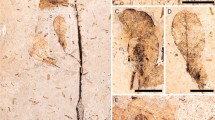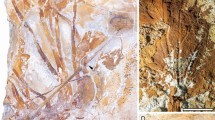Abstract
All the major clades of angiosperms have a fossil record that extends back to more than 100 million years ago (Early Cretaceous), mostly in agreement with molecular dating. However, the Early Cretaceous record of monocots is very poor compared to other angiosperms. Their herbaceous nature has been invoked to explain this rarity, but biogeography could also be an explanation. Unfortunately, most of the Early Cretaceous angiosperm record comes from northern mid-latitudes. The Crato plattenkalk limestone offers a unique window into the Early Cretaceous vegetation of the tropics and has already yielded monocot fossils. Here, we describe a whole monocotyledonous plant from root to reproductive organs that is anatomically preserved. The good preservation of the fossils allowed the evaluation of reproductive, vegetative and anatomical characteristics of monocots, leading to a robust identification of this fossil as a crown monocot. Its occurrence in Northern Gondwana supports the possibility of an early radiation of monocots in the tropics.
This is a preview of subscription content, access via your institution
Access options
Access Nature and 54 other Nature Portfolio journals
Get Nature+, our best-value online-access subscription
$29.99 / 30 days
cancel any time
Subscribe to this journal
Receive 12 digital issues and online access to articles
$119.00 per year
only $9.92 per issue
Buy this article
- Purchase on Springer Link
- Instant access to full article PDF
Prices may be subject to local taxes which are calculated during checkout



Similar content being viewed by others
Data availability
The authors declare that all other data supporting the findings of this study are available in the paper and its supplementary information files or from the corresponding author upon reasonable request.
References
Theophrastus. Enquiry into Plants and Minor Works on Odours and Weather Signs, with an English Translation by Sir Arthur Hort (William Heinemann, 1916).
Ray, J. Historia Plantarum (Mariae Clark, 1686).
Linnaeus, C. Genera Plantarum Eorumque Characteres Naturales (Leyden, 1737).
Gandolfo M. A., Nixon K. C. & Crepet W. L. in Monocots: Systematics and Evolution (eds Wilson, K. L. & Morrison, D. A.) 44–51 (Commonwealth Scientific and Industrial Research Organisation, 2000).
Angiosperm Phylogeny Group. An update of the Angiosperm Phylogeny Group classification for the orders and families of flowering plants: APG II. Bot. J. Linn. Soc. 141, 399–436 (2003).
Friis, E. M., Crane, P. R. & Pedersen, K. R. Early Flowers and Angiosperm Evolution (Cambridge Univ. Press, 2011).
Magallón, S., Gómez‐Acevedo, S., Sánchez‐Reyes, L. L. & Hernández‐Hernández, T. A metacalibrated time‐tree documents the early rise of flowering plant phylogenetic diversity. New Phytol. 207, 437–453 (2015).
Hertweck, K. L. et al. Phylogenetics, divergence times and diversification from three genomic partitions in monocots. Bot. J. Linn. Soc. 178, 375–393 (2015).
Chase, M. W. Monocot relationships: an overview. Am. J. Bot. 91, 1645–1655 (2004).
Kunzmann, L. et al. The Early Cretaceous Crato flora (Araripe Basin, Brazil): floristic, ecological and environmental aspects of an equatorial Gondwanan ecosystem. 13th Symposium on Mesozoic Terrestrial Ecosystems and Biota (eds Martin, T. et al.) 61–62 (2018).
Martill, D. M., Bechly, G. & Loveridge, R. F. The Crato Fossil Beds of Brazil: Window into an Ancient World. (Cambridge Univ. Press, 2007).
Heimhofer, U. & Hochuli, P. A. Early Cretaceous angiosperm pollen from a low-latitude succession (Araripe Basin, NE Brazil). Rev. Palaeobot. Palynol. 161, 105–126 (2010).
Mohr, B. A. R., Bernardes de Oliveira, M. E. C. & Loveridge, B. in The Crato Fossil Beds of Brazil: Window into an Ancient World. (eds Martill D. M. et al.) 537–565 (Cambridge Univ. Press, 2007).
Mohr, B. A. R., Schultka, S., Süss, H. & Bernardes-de-Oliveira, M. E. C. A new drought resistant gymnosperm taxon Duartenia araripensis gen. nov. et sp. nov. (Cheirolepidiaceae?) from the Early Cretaceous of Northern Gondwana. Palaeontogr. Abt. B 289, 1–25 (2012).
Löwe, S. A., Mohr, B. A., Coiffard, C. & Bernardes-de-Oliveira, M. E. Friedsellowia gracilifolia gen. nov. et sp. nov., a new gnetophyte from the Lower Cretaceous Crato Formation (Brazil). Palaeontogr. Abt. B 289, 139–177 (2013).
Mohr, B. A. R. & Eklund, H. Araripia florifera, a magnoliid angiosperm from the Lower Cretaceous Crato Formation (Brazil). Rev. Palaeobot. Palynol. 126, 279–292 (2003).
Mohr, B. A. R., Coiffard, C. & Bernardes-de-Oliveira, M. E. C. Schenkeriphyllum glanduliferum, a new magnolialean angiosperm from the Early Cretaceous of Northern Gondwana and its relationships to fossil and modern Magnoliales. Rev. Palaeobot. Palynol. 189, 57–72 (2013).
Coiffard, C., Mohr, B. A. & Bernardes-de-Oliveira, M. E. Hexagyne philippiana gen. et sp. nov., a piperalean angiosperm from the Early Cretaceous of Northern Gondwana (Crato Formation, Brazil). Taxon 63, 1275–1286 (2014).
Coiffard, C., Mohr, B. A. & Bernardes-de-Oliveira, M. E. The Early Cretaceous Aroid, Spixiarum kipea gen. et sp. nov., and implications on early dispersal and ecology of basal monocots. Taxon 62, 997–1008 (2013).
Doyle, J. A. Fossil evidence on early evolution of the monocotyledons. Q. Rev. Biol. 48, 399–413 (1973).
Doyle, J. A., Endress, P. K. & Upchurch, G. R. Early Cretaceous monocots: a phylogenetic evaluation. Acta Musei Natl. Pragae 64, 59–87 (2008).
Kvaček, J. et al. Pseudoasterophyllites cretaceus from the Cenomanian (Cretaceous) of the Czech Republic: a possible link between Chloranthaceae and Ceratophyllum. Taxon 65, 1345–1373 (2016).
Stevenson, D. W. & Loconte, H. in Monocotyledons: Systematics and Evolution 2 (eds Rudall, P. J. et al.) 543–578 (Royal Botanic Gardens Kew, 1995).
Rudall, P. J., Stevenson, D. W. & Linder, H. P. Structure and systematics of Hanguana, a monocotyledon of uncertain affinity. Aust. Syst. Bot. 12, 311–330 (1999).
Rudall, P. J. Unique floral structures and iterative evolutionary themes in Asparagales: insights from a morphological cladistic analysis. Bot. Rev. 68, 488–509 (2002).
Michelangeli, F. A., Davis, J. I. & Stevenson, D. W. Phylogenetic relationships among Poaceae and related families as inferred from morphology, inversions in the plastid genome, and sequence data from the mitochondrial and plastid genomes. Am. J. Bot. 90, 93–106 (2003).
Petersen, G. et al. Phylogeny of the Alismatales (Monocotyledons) and the relationship of Acorus (Acorales?). Cladistics 32, 141–159 (2016).
Barrett, C. F. et al. Resolving ancient radiations: can complete plastid gene sets elucidate deep relationships among the tropical gingers (Zingiberales)? Ann. Bot. 113, 119–133 (2013).
Givnish, T. J. et al. Phylogenomics and historical biogeography of the monocot order Liliales: out of Australia and through Antarctica. Cladistics 32, 581–605 (2016).
Herendeen, P. S. & Crane, P. R. in Monocotyledons: Systematics and Evolution 2 (eds Rudall, P. J. et al.) 1–21 (Royal Botanic Gardens, Kew, 1995).
Estrada-Ruiz, E., Upchurch, J., Wolfe, J. A. & Cevallos-Ferriz, S. R. S. Comparative morphology of fossil and extant leaves of Nelumbonaceae, including a new genus from the Late Cretaceous of Western North America. Syst. Bot. 36, 337–351 (2011).
Givnish, T. J. et al. Repeated evolution of net venation and fleshy fruits among monocots in shaded habitats confirms a priori predictions: evidence from an ndhF phylogeny. Proc. R. Soc. B 272, 1481–1490 (2005).
Sender, L. M., Doyle, J. A., Upchurch, G. R. Jr, Villanueva-Amadoz, U. & Diez, J. B. Leaf and inflorescence evidence for near-basal Araceae and an unexpected diversity of other monocots from the late Early Cretaceous of Spain. J. Syst. Palaeontol. 0, 1–34 (2018).
Bremer, K. & Janssen, T. Gondwanan origin of major monocot groups inferred from dispersal–vicariance analysis. Aliso 22, 22–27 (2006).
Mohr, B. A., Bernardes-de-Oliveira, M. E., Barale, G. & Ouaja, M. Palaeogeographic distribution and ecology of Klitzschophyllites, an early Cretaceous angiosperm in southern Laurasia and northern Gondwana. Cretac. Res. 27, 464–472 (2006).
Sutton, M. D., Garwood, R. J., Siveter, D. J. & Siveter, D. J. SPIERS and VAXML: a software toolkit for tomographic visualisation and a format for virtual specimen interchange. Palaeontol. Electron. 15, 1–14 (2012).
Goloboff, F., Farris, J. S. & Nixon, K. C. TNT: Tree Analysis using New Technology http://www.zmuc.dk/public/phylogeny (2003).
Mesquite: a modular system for evolutionary analysis v.3.02 (Maddison, W. P. & Maddison, D. R., 2015).
Acknowledgements
We would like to thank the institutions and researchers that made this publication possible. The work has been improved through discussions with various colleagues, especially J. Bogner (Botanical Garden, Munich), P.J. Rudall and B. Mohr. We would also like to thank the staff of the Museum of Natural History, Berlin, L. Maitas for technical help at the herbarium, and C. Radke and H.-J. Götz for part of the photography. We also acknowledge the permission of the curator R. Vogt to the authors for use of the Herbarium of the Berlin Botanical Garden (B) for comparative work. Funding was provided by the German Funding Agency (DFG), which provides support for C.C. (grant No. CO 1060/3-1). There is also a contribution to the Project CNPq 310823/2016-1 Research Productivity Grant for M.E.C.B. as senior collaborator professor in IGc/USP, Brazil.
Author information
Authors and Affiliations
Contributions
C.C. contributed to the design and scope of the paper and the evaluations of the fossil taxa discussed in the paper. N.K. and I.M. provided the data and tomographic analysis of the fossil. C.C., N.K. and M.E.C.B. contributed to writing and revising the manuscript.
Corresponding author
Ethics declarations
Competing interests
The authors declare no competing interests.
Additional information
Peer review information: Nature Plants thanks James Doyle and the other, anonymous, reviewer(s) for their contribution to the peer review of this work.
Publisher’s note: Springer Nature remains neutral with regard to jurisdictional claims in published maps and institutional affiliations.
Supplementary information
Supplementary Information
Fossil analysis, Supplementary Fig. 1 and matrix.
Rights and permissions
About this article
Cite this article
Coiffard, C., Kardjilov, N., Manke, I. et al. Fossil evidence of core monocots in the Early Cretaceous. Nat. Plants 5, 691–696 (2019). https://doi.org/10.1038/s41477-019-0468-y
Received:
Accepted:
Published:
Issue Date:
DOI: https://doi.org/10.1038/s41477-019-0468-y
This article is cited by
-
A new remarkable Early Cretaceous nelumbonaceous fossil bridges the gap between herbaceous aquatic and woody protealeans
Scientific Reports (2023)
-
The impacts of allopolyploidization on Methyl-CpG-Binding Domain (MBD) gene family in Brassica napus
BMC Plant Biology (2022)
-
First evidence of ranunculids in Early Cretaceous tropics
Scientific Reports (2022)
-
The slow-evolving Acorus tatarinowii genome sheds light on ancestral monocot evolution
Nature Plants (2022)
-
Revealing the diversity of amber source plants from the Early Cretaceous Crato Formation, Brazil
BMC Evolutionary Biology (2020)



